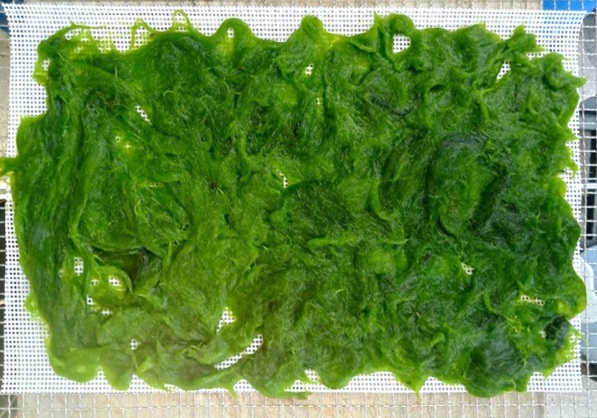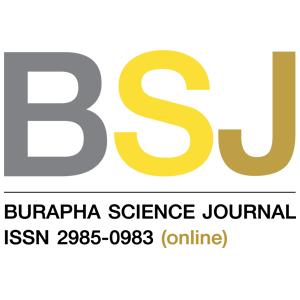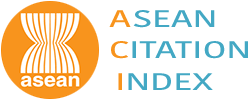การประเมินประสิทธิภาพการยับยั้งเอนไซม์ไลเปส ปริมาณฟีนอลิกทั้งหมด และฤทธิ์ต้านอนุมูลอิสระของสารสกัดจากสาหร่ายเตา Spirogyra sp. จากโรงเรือนระบบปิดแบบน้ำหมุนเวียน
คำสำคัญ:
เอนไซม์ไลเปส , สาหร่ายเตา , ฤทธิ์ต้านอนุมูลอิสระ , สารประกอบฟีนอลิกบทคัดย่อ
วัตถุประสงค์และที่มา : โรคอ้วนเกิดจากความผิดปกติของสมดุลไขมันในร่างกายและมีภาวะไขมันในเลือดสูง นำไปสู่การเกิดโรคเรื้อรังต่าง ๆ เช่น โรคหัวใจและหลอดเลือด โรคเบาหวาน และความดันโลหิตสูง เอนไซม์ที่สำคัญในการย่อยไขมันคือ เอนไซม์ไลเปส การยับยั้งเอนไซม์ไลเปสช่วยลดการย่อยไขมันที่จะถูกดูดซึมเข้าสู่เซลล์ร่างกายทำให้ระดับไขมันในเลือดลดลง การศึกษาสารสกัดจากธรรมชาติหลายชนิดที่มีฤทธิ์ยับยั้งเอนไซม์ไลเปสจึงช่วยลดสัดส่วนการใช้ยาสังเคราะห์ที่มีผลข้างเคียงต่อร่างกายเมื่อใช้ยาต่อเนื่องได้ ดังนั้น วัตถุประสงค์ของการวิจัยนี้ คือ ศึกษาประสิทธิภาพการยับยั้งเอนไซม์ไลเปส ปริมาณ ฟีนอลิกทั้งหมด และฤทธิ์ต้านอนุมูลอิสระในสาหร่ายเตา (Spirogyra sp.) ซึ่งเป็นสาหร่ายสีเขียวน้ำจืดขนาดใหญ่ที่มีคุณค่าทางโภชนาการและสารต้านอนุมูลอิสระเช่น สารประกอบฟีนอลิกและฟลาโวนอยด์ในปริมาณสูง แต่ปริมาณสารสำคัญต่างๆจะแตกต่างกันออกไปตามแหล่งน้ำที่สาหร่ายอาศัยอยู่ ทำให้คุณภาพและปริมาณผลผลิตของสาหร่ายตามธรรมชาติไม่คงที่ในการศึกษานี้จึงใช้สาหร่ายเตาได้จากการเพาะเลี้ยงในโรงเรือนระบบปิดแบบน้ำหมุนเวียนซึ่งมีการควบคุมสภาวะการเพาะเลี้ยงให้ปริมาณผลผลิตและคุณภาพสาหร่ายคงที่ และไม่มีการปนเปื้อนจากสารพิษเนื่องจากมีการปรับปรุงคุณภาพน้ำก่อนและหลังใช้งาน ซึ่งยังไม่มีงานวิจัยที่ทำการประเมินประสิทธิภาพการยับยั้งเอนไซม์ไลเปส ปริมาณฟีนอลิกทั้งหมด และฤทธิ์ต้านอนุมูลอิสระในสาหร่ายเตาที่เพาะเลี้ยงในโรงเรือนระบบปิดแบบน้ำหมุนเวียนมาก่อน
วิธีดำเนินการวิจัย : ตัวอย่างสาหร่ายเตาได้จากการเพาะเลี้ยงในโรงเรือนระบบปิดแบบน้ำหมุนเวียน ปริมาตร 1,000 ลิตร หลังคาอะคลิลิกใสแสงผ่านได้ มีการบำบัดน้ำก่อนและหลังด้วยการตกตะกอนร่วมกับการพ่นอากาศ เก็บตัวอย่างสาหร่ายนำไปล้างให้สะอาด แล้วนำไปอบแห้งที่อุณหภูมิ 50 องศาเซลเซียส นาน 2 วัน บดให้ละเอียด นำตัวอย่างผงแห้งไปสกัดแบบมาซเซอเรชันด้วยเอทานอลร้อยละ 70 ในอัตราส่วนตัวอย่างผงแห้งต่อตัวทำละลาย=1:5 โดยน้ำหนักต่อปริมาตร นาน 48 ชั่วโมง แล้วระเหยแห้งให้ได้สารสกัดหยาบ จากนั้นนำสารสกัดหยาบไปวิเคราะห์ฤทธิ์ยับยั้งเอนไซม์ไลเปสจากตับอ่อนด้วยวิธีวัดอัตราการปล่อยกรดโอเลอิกจากการสลายของไตรโอเลอินเทียบกับยา Xenical (สารมาตรฐานออร์ลิสแตท) ปริมาณสารประกอบฟีนอลิกทั้งหมดด้วยวิธี Folin–Ciocalteu phenol reagent ฤทธิ์ยับยั้งอนุมูลอิสระดีพีพีเอช จลนศาสตร์การยับยั้งเอนไซม์ด้วย Lineweaver-Burg plot จากสมการ Michaelis-Menten และความสัมพันธ์ของฤทธิ์ยับยั้งเอนไซม์ไลเปสกับปริมาณสารประกอบฟีนอลิกและฤทธิ์ต้านอนุมูลอิสระโดยใช้สหสัมพันธ์ของ Pearson
ผลการวิจัย : ผลการวิจัยพบว่า ร้อยละของการยับยั้งเอนไซม์ไลเปสเพิ่มขึ้นเมื่อเพิ่มความเข้มข้นของสารสกัด (p0.05) ฤทธิ์ยับยั้งการทำงานของเอนไซม์ไลเปสของสารสกัดสาหร่ายเตาและยารักษาโรคอ้วนยี่ห้อ Xenical ที่ความเข้มข้นเท่ากันคือ 40 มิลลิกรัมต่อมิลลิลิตร มีค่าเท่ากับร้อยละ 23.81±0.97 และ 85.71±2.33 ตามลำดับ, IC50 เท่ากับ 90.91±1.83 และ 16.67±1.87 มิลลิกรัมต่อมิลลิลิตร ตามลำดับ จะเห็นว่า ร้อยละของการยับยั้งเอนไซม์ของยา Xenical สูงกว่าสารสกัดสาหร่ายเตา 3.59 เท่า ค่า IC50 (ความเข้มข้นที่สามารถยับยั้งเอนไซม์ไลเปสได้ร้อยละ 50) ของยา Xenical ต่ำกว่าสารสกัดสาหร่ายเตา 5.45 เท่า ค่า IC50 ที่ต่ำกว่าแสดงว่ามีฤทธิ์ยับยั้งเอนไซม์ได้ดีกว่า แม้ว่าประสิทธิภาพการยับยั้งเอนไซม์ของสารสกัดจากสาหร่ายเตาจะต่ำกว่ายา Xenical แต่ก็ถือว่าสารสกัดสาหร่ายเตามีศักยภาพในการยับยั้งเอนไซม์ไลเปสได้ พฤติกรรมการยับยั้งเอนไซม์ของสารสกัดเป็นการยับยั้งแบบไม่แข่งขันเมื่อพิจารณาจากค่า Vmax, Km, Ki และ Ki' ที่ได้จาก Lineweaver-Burg plot นั่นคือ Vmax (อัตราเร็วการเกิดปฏิกิริยาสูงสุด) ลดลงอย่างมีนัยสำคัญ (p
0.05) แต่ Km (ค่าคงที่ Michaelis-Menten constant) คงที่ (p>0.005) และค่า Ki มากกว่าค่า Ki' (ค่าคงที่การยับยั้ง) พฤติกรรมการยับยั้งแบบนี้หมายความว่า ตัวยับยั้งจะจับได้ทั้งเอนไซม์หรือเอนไซม์-สับสเตรตคอมเพล็กซ์ที่ตำแหน่งอัลโลสเตอริกทำให้เอนไซม์ไม่สามารถทำงานได้ นอกจากนี้ สารสกัดสาหร่ายเตามีปริมาณฟีนอลิกทั้งหมด 36.65±0.25 มิลลิกรัมกรดแกลลิกต่อกรัม ฤทธิ์ยับยั้งอนุมูลอิสระดีพีพีเอชเท่ากับ 3.13±0.03 มิลลิกรัมโทรล็อกซ์ต่อกรัม หรือคิดเป็นร้อยละ 70.30±0.64 จากสัมประสิทธิ์สหสัมพันธ์ของ Pearson พบว่า ร้อยละการยับยั้งเอนไซม์ไลเปสกับปริมาณสารประกอบฟีนอลิกทั้งหมดในสารสกัดมีความสัมพันธ์กันสูง (r=0.8224) และมีความสัมพันธ์กับฤทธิ์ต้านอนุมูลดีพีพีเอชปานกลาง (r=0.7145) ชี้ให้เห็นว่า สารประกอบฟีนอลิกและฤทธิ์ต้านอนุมูลอิสระในสารสกัดมีบทบาทสำคัญในการยับยั้งเอนไซม์ไลเปส โดยทั่วไปสารสกัดธรรมชาติที่มีสารประกอบฟีนอลิก ฟลาโวนอยด์ และฤทธิ์ต้านอนุมูลอิสระสูง ๆ มักตรวจพบฤทธิ์ยับยั้งการทำงานของเอนไซม์ไลเปสสูงตามไปด้วย
สรุปผลการวิจัย : ผลการวิจัยในครั้งนี้แสดงให้เห็นว่า สารสกัดจากสาหร่ายเตาที่เพาะเลี้ยงในโรงเรือนระบบปิดแบบน้ำหมุนเวียนซึ่งมีการควบคุมสภาวะการเพาะเลี้ยงให้ปริมาณและคุณภาพสาหร่ายคงที่ มีฤทธิ์ยับยั้งเอนไซม์ไลเปสได้ สารสกัดมีปริมาณสารประกอบฟีนอลิกและฤทธิ์ต้านอนุมูลอิสระสูงซึ่งมีผลต่อประสิทธิภาพการยับยั้งเอนไซม์ สารสกัดจากสาหร่ายเตาจึงมีศักยภาพในการพัฒนาเป็นผลิตภัณฑ์เพื่อสุขภาพได้ อย่างไรก็ตาม การวิจัยนี้เป็นเพียงการประเมินประสิทธิภาพการยับยั้งเอนไซม์ไลเปสในหลอดทดลอง (in vitro) เท่านั้น การศึกษาตัวยับยั้งเอนไซม์ไลเปสจากสารสกัดธรรมชาติควรทำการทดลองเพิ่มเติมอาจทำในเซลล์เพาะเลี้ยง (in vitro) รวมถึงในสัตว์ทดลอง (in vivo) เพื่อยืนยันประสิทธิภาพที่แท้จริง ผลข้างเคียง และความปลอดภัยของการใช้สารสกัดต่อไป
เอกสารอ้างอิง
Abdel-Aal, E.I., Haroon, A.M., & Mofeed, J. (2015). Successive solvent extraction and GC–MS analysis for the evaluation of the phytochemical constituents of the filamentous green alga Spirogyra longata. Egyptian Journal of Aquatic Research, 41, 233–246. doi.org/10.1016/j.ejar.2015.06.001
Amornlirdpisarn, D., Mengumpun, K., & Rattanapoj, T. (2013). Cultivation of organic Spirogyra for use in health supplements and cosmeceutical products. Cooperative Research Program Report, 98 p. (in Thai)
Bjerregaard, L.H., & Baker, J.L. (2018). Change in overweight from childhood to early adulthood and risk of type 2 diabetes. The New England Journal of Medicine, 378(26), 2537–2538. doi.org/10.1056/NEJMoa1713231
Candela, M.F., Arenas, N.E., Caicedo, O., & Malagón, A. (2021). Inhibition of lipase by orlistat: kinetics combined with in silico approaches to visualize interactions. Journal of Chemical Education, 98, 1762-1767. doi:10.1021/acs.jchemed.0c01184
Cao, Q.W., Mei, S., Mehmood, A., Sun, Y., & Chen, X.M. (2024). Inhibition of pancreatic lipase by coffee leaves-derived polyphenols: a mechanistic study. Food Chemistry, 444, 138514. doi.org/10.1016/j.foodchem.2024.138514
Chater, P.I., Wilcox, M., Cherry, P., Herford, A., Mustar, S., Wheater, H., Brownlee, I., Seal, C., & Pearson, J. (2016). Inhibitory activity of extracts of Hebridean brown seaweeds on lipase activity. Journal of Applied Phycology, 28, 1303-1313. doi:10.1007/s10811-015-0619-0
Das, J., & Ghosh, K. (2023). Nutrient profiling of five freshwater algae for their prospective use as fish feed ingredients. Algal Research, 74, 103173. doi.org/10.1016/j.algal.2023.103173
Dechakhamphu, A., & Wongchum, N. (2022). Investigation of the kinetic properties of Phyllanthus chamaepeuce Ridl. extracts for the inhibition of pancreatic lipase activity. Journal of Herbal Medicine, 32, 100508. doi.org/10.1016/j.hermed.2021.100508
Donsujit, W., Saetia, W., & Lirdwitayaprasit, T. (2023). Cultivation of Toa macroalgae (Spirogyra sp.) in greenhouse with water from rearing Nile Tilapia, Burapha Science Journal, 28(1), 570-587. (in Thai)
Duangjai, A., Limpeanchob, N., Trisat, K., & Amornlerdpison, D. (2016). Spirogyra neglecta inhibits the absorption and synthesis of cholesterol in vitro. Integrative Medicine Research, 5, 301–308. doi.org/10.1016/j.imr.2016.08.004
Du, X.P., Bai, M.L., Huang, Y., Jiang, Z.D., Chen, F., Ni, H., & Li, Q.B. (2018). Inhibitory effect of astaxanthin on pancreatic lipase with inhibition kinetics integrating molecular docking simulation. Journal of Functional Foods, 48, 551-557. doi.org/10.1016/j.jff.2018.07.045
Eom, S.H., Lee, M.S., Lee, E.W., Kim, Y.M., & Kim, T.H. (2013). Pancreatic lipase inhibitory activity of phlorotannins isolated from Eisenia bicyclis. Phytotherapy Research, 27, 148–151. doi.org/10.1002/ptr.4694
Eseberri, I., Trepiana, J., Léniz, A., Gómez-Garcia, I., González, M.C.U., & Portillo, M.P. (2022). Variability in the beneficial effects of phenolic compounds: a review. Nutrients, 14(9), 1925.
Gonzalez-Castejon, M., & Rodriguez-Casado, A. (2011). Dietary phytochemicals and their potential effects on obesity: a review. Pharmacology Research, 64, 438-455. doi.org/10.1016/j.phrs.2011.07.004
Habtemariam, S. (2013). Antihyperlipidemic components of Cassia auriculata aerial parts: identification through in vitro studies. Phytotherapy Research, 27, 152-155. doi.org/10.1002/ptr.4711
Hsu, C.L., & Yen, G.C. (2008).Phenolic compounds: evidence for inhibitory effects against obesity and their underlying molecular signaling mechanisms. Molecular Nutrition & Food Research, 52,53-61. doi.org/10.1002/mnfr.200700393
Huerta, V., Mihalik, K., Maitin, V., Crixell, S.H., & Vattem, D.A. (2007). Effect of Central/South American medicinal plants on energy harvesting ability of the mammalian GI tract. Journal of Medicinal Plants Research, 1(2), 38-49.
Inthongkaew, P. (2016). Alpha-glucosidase and Lipase Inhibitors from Dendrobium formosum. M.S. Thesis. Chulalongkorn University. Bangkok. (in Thai)
Khatchapuridze, Z., Ploeger, A., & Gulua, L. (2023). Kinetic behavior of pancreatic lipase inhibition by wine. Food Research, 7(3), 157-164. doi.org/10.26656/fr.2017.7(3).151
Koga, K., Hisamura, M., Kanetaka, T., Yoshino, K., Matsuo, Y., & Tanaka, T. (2013). Proanthocyanidin oligomers isolated from Salacia reticulata leaves potently inhibit pancreatic lipase activity. Journal of Food Science, 78, 105–111. doi.org/10.4236/ojped.2013.32020
Liu, T.T., Liu, X.T., Chen, Q.X., & Shi, Y. (2020). Lipase inhibitors for obesity: a review. Biomedicine & Pharmacotherapy, 128, 110314. doi.org/10.1016/j.biopha.2020.110314
Lunagariya, N.A., Patel, N.K., Jagtap, S.C., & Bhutani, K.K. (2014). Inhibitors of pancreatic lipase: state of art and clinical perspectives. EXCLI Journal, 13, 897-921.
Mohammed, D.H. & Al-Katib, M.A. (2023). Active and phenolic compounds in Spirogyra sp. PDNA1 is an antibiotic for some bacteria and fungi. Al-Kitab Journal for Pure Sciences, 7(1), 100-113. doi.org/10.32441/kjps.07.01.p9
Oboh, G., Agunloye, O.M., Adefegha, S.A., Akinyemi, A.J., & Ademiluyi, A.O. (2015). Caffeic and chlorogenic acids inhibit key enzymes linked to type-2 diabetes (in vitro): a comparative study. Journal of Basic and Clinical Physiology and Pharmacology, 26(2), 165-70. doi.org/10.1515/jbcpp-2013-0141
Peerapornpisal, Y., Kanjanapothi, D., Taesotikul, T., & Amornlerdpison, D. (2009). Potential of some freshwater algae in Northern Thailand as nutraceutical. Phycologia, 48(4)Suppl, 104-112. (in Thai)
Peerapornpisal, Y., Panyoyai, T., & Amornlerdpison, D. (2012). Antioxidant and anti-inflammatory activities of Spirogyra neglecta (Hassall) Kutzing. KKU Science Journal, 40(1), 228-235. (in Thai)
Peerapornpisal, Y. (2015). Freshwater Algae in Thailand. (3rd ed.). Chiang Mai: Chotana Print.
Phattarasupa, P., Rimkeeree, H., & Dhamvithee, P. (2018). Effect of the extraction conditions on antioxidant activity and total phenolic contents of Spirogyra spp. liquid extract. In Proceedings of 56th Kasetsart University Annual Conference: Science and Genetic Engineering, Architecture and Engineering,
Agro-Industry, Natural Resources and Environment. (pp. 663-670). Thailand. (in Thai)
Phonrin, A. (2017). Determination of Total Phenolic and Antioxidant Activity in Freshwater Macroalgae from Nan Province. M.S. Thesis. Burapha University. (in Thai)
Sharma, N., Sharma, V.K., & Seo, S.Y. (2005). Screening of some medicinal plants for anti-lipase activity. Journal of Ethnopharmacology, 97(3), 453-456. doi.org/10.1016/j.jep.2004.11.009
Shimada, K., Fujikawa, K., Yahara, K., & Nakamura, T. (1992). Antioxidative properties of xanthans on the autoxidation of soybean oil in cyclodextrin emulsion. Journal of Agricultural and Food Chemistry, 40(6), 945–948. doi.org/10.1021/jf00018a005
Sirirustananun, N., & Chanartaeparporn, P. (2015). Nutrient contents and growth of Spirogyra spp. in water resources of Phetchabun province. Journal of Agricultural Research and Extension, 32(1), 58-66.
Sitthiwong, N., Sumangka, J., Michaitrakun, S., & Sotthisawad, K. (2024). Total phenolic compound and antimicrobial activity of Spirogyra spp. Progress in applied science and technology, 14(1), 65-72. doi.org/10.60101/past.2024.252833
Srimoon, R., Anartgnam, P., & Tilarux, P. (2020). In vitro inhibitory efficiency of Ventilago denticulata Willd. dried leaves extract on alpha-glucosidase, alpha-amylase and lipase and antioxidant activities. Science & Technology Asia, 25(4), 135-149.
Srimoon, R. (2020). Phenolic Compounds and Antioxidant activity in Plants. Bangkok: OS Printing House. (in Thai)
Tipnee, S., Ramaraj, R., & Unpaprom, Y. (2015). Nutritional evaluation of edible freshwater green macroalga Spirogyra varians. Emergent Life Sciences Research, 1(2), 1-7.
Wizi, J., Ni, L., Darkwah, W.K., & Xianglan, L. (2022). Analysis of bioactive compounds from different algae samples extracted with ultrasound: characterization, phytochemical contents and antioxidant potentials. Pharmacognosy Research, 14(1), 35-44. doi.org/10.5530/pres.14.1.7
Wongsawad, P., & Peerapornpisal, Y. (2015). Morphological and molecular profiling of Spirogyra from Northeastern and Northern Thailand using inter simple sequence repeat (ISSR)markers. Saudi Journal of Biological Sciences, 22, 382–389. doi.org/10.1016/j.sjbs.2014.10.004
Wong, S.P., Leong, L.P., & Koh, J.H.W. (2006). Antioxidant activities of aqueous extracts of selected plants. Food Chemistry, 99, 775-783. doi.org/10.1016/j.foodchem.2005.07.058
Yosboonruang, A., Duangjai, A., Amornlerdpison, D., & Viyoach, J. (2020). Screening for biological activities of Spirogyra neglecta water extract. Walailak Journal of Science and Technology, 17(4), 359-368.

ดาวน์โหลด
เผยแพร่แล้ว
รูปแบบการอ้างอิง
ฉบับ
ประเภทบทความ
สัญญาอนุญาต
ลิขสิทธิ์ (c) 2025 คณะวิทยาศาสตร์ มหาวิทยาลัยบูรพา

อนุญาตภายใต้เงื่อนไข Creative Commons Attribution-NonCommercial-NoDerivatives 4.0 International License.
Burapha Science Journal is licensed under a Creative Commons Attribution-NonCommercial-NoDerivatives 4.0 International (CC BY-NC-ND 4.0) licence, unless otherwise stated. Please read our Policies page for more information


